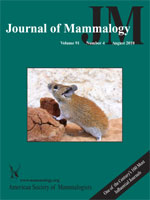Dietary plasticity and diet composition of Pallas's cat (Otocolobus manul) was quantified in central Mongolia. Diet of Pallas's cat was assessed by scat analyses, and prey surveys were used to estimate prey availability. Prey selection was calculated using multinomial likelihood ratio tests. Analysis of 146 scats identified 249 prey items. Pallas's cats ate a broad range of small mammals, insects, birds, reptiles, and carrion, but Daurian pikas (Ochotona dauurica) were the most frequently consumed prey. Multinomial likelihood ratio tests indicated nonrandom selection of prey species. Pikas were selected disproportionately to their availability, and other more numerous prey items were used less than expected, indicating feeding specialization. Specialization on pikas appears to optimize energy intake per unit foraging by Pallas's cats, because pikas are 2–4 times larger than other small mammal prey. We argue that pika control programs in China and Mongolia potentially threaten Pallas's cat populations, because no other prey species could fill the niche occupied by the pika in terms of size and year-round availability.
How to translate text using browser tools
16 August 2010
Dietary composition, plasticity, and prey selection of Pallas's cats
Steven Ross,
Bariushaa Munkhtsog,
Stephen Harris
ACCESS THE FULL ARTICLE

Journal of Mammalogy
Vol. 91 • No. 4
August 2010
Vol. 91 • No. 4
August 2010
diet
Mongolia
niche specialization
Otocolobus manul
Pallas's cat
pika
selection




